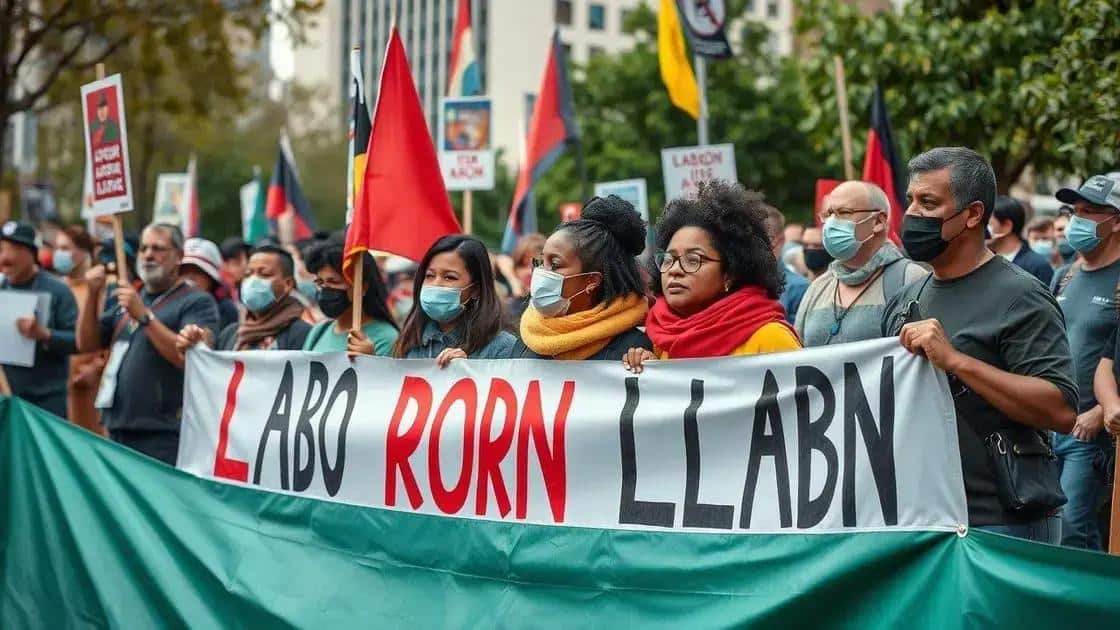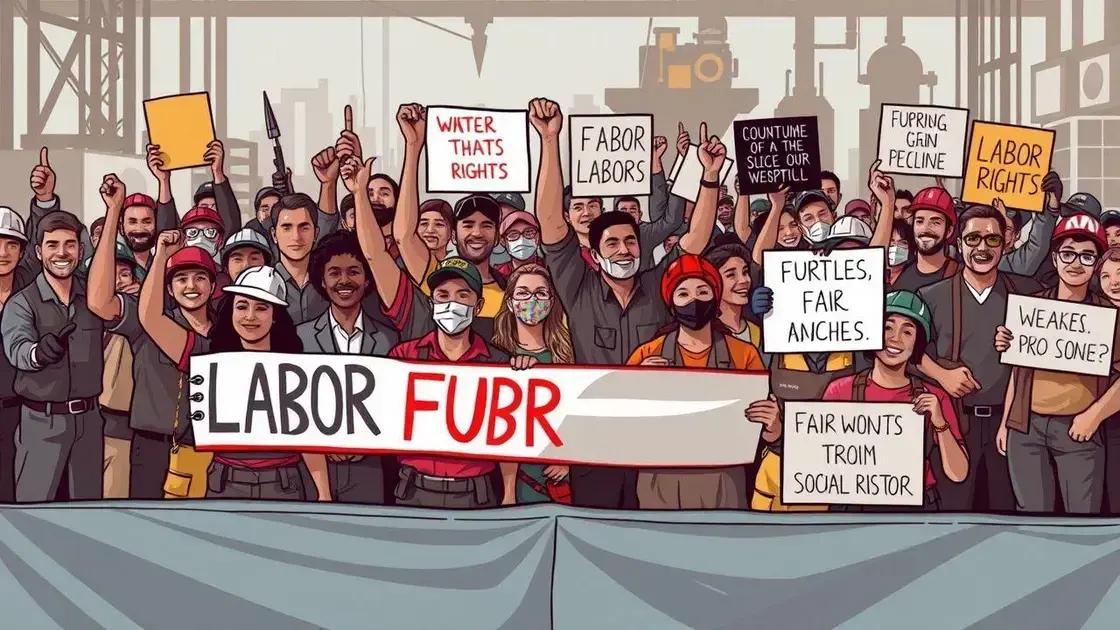Particular labor movement stories that inspire change

Labor movements advocate for workers’ rights by improving conditions, ensuring fair wages, and adapting to modern challenges like the gig economy, thereby shaping today’s workforce.
Particular labor movement stories have the power to inspire and connect us. By exploring these unique narratives, we uncover the struggles and triumphs that shape the fight for workers’ rights. Are you curious about the voices that have made a difference?
The origins of labor movements
The origins of labor movements are rooted in the struggles of workers seeking better conditions. Understanding where these movements come from helps us appreciate their ongoing impact.
Early Beginnings
In the late 18th and early 19th centuries, the rise of industrialization created harsh working environments. Workers faced long hours, low wages, and dangerous conditions. The first organized efforts aimed at improving these conditions emerged as people began to unite.
Key Events That Shaped Labor Movements
Significant events set the foundation for organized labor:
- The Factory Acts of the 1830s aimed to improve labor conditions.
- Strikes in the 1840s drew attention to workers’ rights.
- The formation of the first trade unions established a collective voice for workers.
Throughout the 19th century, these movements grew and evolved. As more workers joined forces, they pushed for reforms to protect their rights.
Global influences also played a role. In various countries, like the United States and Britain, the labor movements were significantly impacted by political changes. Rights to organize were often met with resistance but eventually gained legal recognition.
Modern Impacts
The early labor movements laid the groundwork for today’s labor laws. Achievements such as the eight-hour workday and minimum wage laws owe their existence to these early fighters for workers’ rights. It’s important to recognize their sacrifices and contributions, as they continue to resonate in current discussions about labor rights.
Understanding the origins of labor movements equips us to better engage with ongoing conversations about workers’ rights today. How have these stories shaped your view on modern labor issues?
Key figures in the labor movement
Throughout history, key figures in the labor movement have emerged as champions for workers’ rights. These individuals played vital roles in shaping labor policies and advocating for better working conditions.
Important Leaders
Some remarkable leaders have made significant contributions:
- Mother Jones: A tireless activist who fought for miners’ rights and worked to organize strikes.
- Samuel Gompers: Founder of the American Federation of Labor (AFL), he focused on practical reforms for workers.
- John L. Lewis: A prominent advocate for the United Mine Workers, he emphasized the importance of unions.
These figures were not just leaders; they were also voices for the voiceless. Their efforts brought attention to the struggles faced by workers across various industries.
Influencing Change
Key figures influenced changes in laws and public attitudes. For instance, Gompers emphasized the need for fair wages and better working hours. His efforts led to significant legislation that improved labor standards. Mother Jones’ activism inspired many to join the cause.
As movements gained momentum, leaders faced challenges from both employers and the government. However, their determination led to key victories that changed the landscape of workers’ rights forever.
Understanding the contributions of these historical figures is important. They remind us of the ongoing fight for labor rights and the importance of solidarity among workers. Today, their legacies inspire new generations to advocate for fair treatment in the workplace.
Impact of labor movements on society

The impact of labor movements on society has been profound and far-reaching. These movements have not only shaped the rights of workers but have also influenced economic policies and social justice.
Improvements in Labor Rights
Labor movements have led to many advances in workers’ rights. These include:
- The establishment of the eight-hour workday.
- Improvements in workplace safety standards.
- The introduction of minimum wage laws.
- Protection for workers against discrimination and unfair treatment.
By advocating for these rights, labor movements have helped create a safer and fairer work environment for millions. The changes they initiated continue to benefit workers today.
Economic Influence
Beyond individual rights, labor movements have had significant economic impacts. When workers unite, they advocate for fair pay and better conditions, which can affect local and national economies. A well-paid workforce contributes to:
- Increased consumer spending.
- Sustainable economic growth.
- Improved productivity.
As workers fight for fair compensation, they help stimulate the economy, directly impacting businesses and communities.
Labor movements have also played a crucial role in shaping policies that promote social equity. By pushing for changes that benefit not just workers but society as a whole, they have influenced legislation that tackles poverty and inequality. For instance, the fights for healthcare reforms and retirement benefits highlight the movements’ commitment to the overall well-being of families and communities.
Understanding the impact of labor movements on society allows us to appreciate their ongoing importance. They have paved the way for continued advocacy and reform, ensuring that workers’ voices remain vital in conversations about fairness and justice.
Recent developments in labor movements
Recent developments in labor movements reflect ongoing struggles and successes in the fight for workers’ rights. These movements adapt to new challenges brought about by changes in the economy, technology, and society.
Adapting to Technology
The rise of technology in the workplace has transformed how labor movements operate. With more people working in gig and freelance roles, labor organizations are striving to support these workers. Initiatives have emerged to:
- Advocate for benefits and protections for gig workers.
- Push for minimum wage standards in new job sectors.
- Utilize online platforms to organize and unite workers.
This technological shift has necessitated a reevaluation of traditional labor practices and strategies.
Legislative Changes
Recent legislative efforts have aimed to strengthen labor rights. Some key developments include:
- Introduction of laws to enhance workplace safety measures.
- Proposals to increase the minimum wage at national levels.
- New laws aimed at stopping workplace harassment and discrimination.
These changes showcase how labor movements actively engage with policymakers to improve conditions for workers. They remind us of the ongoing battle for justice and equality in the workplace.
Alongside legislative changes, grassroots movements have risen in prominence. Workers across industries are banding together to voice their concerns and demand better treatment. Protests and strikes are making headlines once again, showcasing the power of collective action. Many organizations are utilizing social media to spread awareness and mobilize support for their causes.
Understanding these recent developments in labor movements highlights the importance of worker solidarity in today’s changing landscape. As these movements continue to evolve, they remain crucial in battling injustices faced by workers in various sectors.
How labor movements shape today’s workforce
Labor movements play a crucial role in shaping today’s workforce. They advocate for workers’ rights, pushing for fair wages, better working conditions, and equitable treatment in the workplace.
Current Advocacy Efforts
Modern labor movements focus on several important issues, including:
- Equal pay: Advocating for wage equality among all employees, regardless of gender or background.
- Job security: Pushing for contracts and protections that ensure stable employment.
- Protection against discrimination: Raising awareness and fighting laws that safeguard against unfair treatment.
These efforts address critical needs for workers in diverse industries, ensuring a fairer environment.
Impact on Job Markets
Labor movements also influence job markets by promoting favorable policies that enhance labor rights. For example, movements have successfully campaigned for:
- Stronger labor laws that protect workers.
- Health and safety regulations to ensure safer workplaces.
- Support for unionization efforts across sectors.
These initiatives contribute to a healthy economy by ensuring workers are treated fairly and compensated justly. When workers are satisfied, they perform better, driving productivity higher.
The rise of the gig economy has also led labor movements to adapt their strategies. As more people take on freelance or gig work, these organizations are expanding their focus. They now advocate for benefits like health insurance and retirement plans for non-traditional workers. This shift demonstrates how labor movements continue to evolve, meeting modern challenges head-on.
Understanding how labor movements shape today’s workforce encourages ongoing support for these vital initiatives. Their work impacts the day-to-day lives of millions, striving for a just and equitable labor environment for all.
FAQ – Frequently Asked Questions about Labor Movements
What are labor movements?
Labor movements are organized efforts by workers to advocate for better working conditions, fair wages, and workers’ rights.
How do labor movements impact today’s workforce?
Labor movements shape the workforce by pushing for fair treatment, improved labor laws, and better working environments.
What recent changes have occurred in labor movements?
Recent changes include focusing on gig economy workers, advocating for equal pay, and pushing for legislation to protect workers’ rights.
Why is worker solidarity important?
Worker solidarity helps strengthen the collective voice of workers, enabling them to effectively advocate for their rights and interests.






